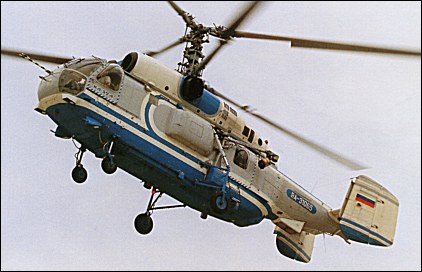
Brazilian and Russian Military Cooperation Deepens
Publication: Eurasia Daily Monitor Volume: 5 Issue: 224
By:

According to Russia’s Economic Development Ministry, Russia is negotiating to supply helicopters to the Forca Aerea Brasileira (Brazilian Air Force, or FAB). The Ministry noted in a statement, "In order to promote Russian helicopters, the Mi-171A helicopter has completed, and the Ka-32A helicopter is currently going through, the certification procedure in Brazil" (Interfaks-Agentstvo Voyennykh Novostei, November 19).
The FAB is the largest air force in Latin America, operating 729 aircraft, including 165 fighters and 90 helicopters (www.fab.mil.br/portal/capa/index.php). The FAB does not currently operate a single Russian-built aircraft, though last year it considered the Sukhoi Su-35 fighter for its Project FX-2 fighter upgrade replacement program.
What is notable about the FAB’s aerial fleet is that Brazil’s growing aeronautical industry is responsible for an increasing share of its planes, as 479 FAB aircraft, nearly 66 percent of the total, were manufactured or assembled in Brazil; they included 107 combat aircraft (65 percent) and 35 helicopters (38 percent). Just over half of the FAB helicopter fleet is American-made and consists of 43 Bell UH-1 Iroquois and three Bell 206 JetRangers. FAB also operates 10 Eurocopter AS-332 Cougars.
It is the remainder of the FAB helicopter fleet, however, that provides the rationale behind FAB’s interest in Russia’s offerings. FAB operates 25 Helibras HB-350Bs and three Helibras HB-355s, all constructed by a consortium of Brazil, France, Germany, and Spain. The Brazilian government has made it a high priority for any new military purchases to involve technology transfers, a process that Washington strongly resists.
On November 19 Brazil’s Minister of Foreign Affairs Celso Amorim affirmed that the Brazilian government’s purchase of Russian defense equipment would occur only if the transaction included the transfer of technology, saying that the Russian negotiators were well aware of the condition and that if it were not met, Brazil had to go elsewhere. Amorim said bluntly, "Brazil will not buy military equipment without a technology transfer, because the purchase is part of a political plan of national industrial and technological development” (Agencia Estado, November 19). Brasilia has consistently fostered its aircraft industry. Its best-known builder of civilian aircraft, Embraer (Empresa Brasileira de Aeronautica) has close ties to the FAB, which originally directly managed and sponsored the enterprise. Amorim added that the helicopter deal and the technology transfer would be a prime topic of conversation when Russian President Dmitry Medvedev visits Brazil from November 24 to 26.
In a further example of Brazil’s growing martial confidence, the country is also conducting military exercises with its neighbors and on November 1 began Operation Cruzeiro do Sul IV (CRUZEX IV), the largest air-combat exercise in South America. Operating in conjunction with the FAB were air force elements from Argentina, France, Chile, Uruguay, and Venezuela (www.cruzex.aer.mil.br/). CRUZEX’s motto was "A guerra e simulada. O treinamento, real" ("The war is simulated. The training, real.")
CRUZEX IV aircraft operated from Brazil’s Natal Air Base (BANT) in Rio Grande do Norte state, but the aerial exercise also covered Brazil’s northeastern states of Pernambuco, Para, and Ceara (Tribuno do Norte, November 8). By the time the war games ended, the participants had flown 650 sorties. Even though Washington could only watch from afar, CRUZEX was hardly an anti-American exercise. While its "objectivos" were to "Train members of the Air Operations Command of the Brazilian Air Force (FAB) in planning joint operations with the Air Forces of friendly countries," they also included “Training the participants in the structure of the NATO Command and Control of Air Operations in planning, mounting, and conducting operations in a crisis and low-intensity conflicts” (www.cruzex.aer.mil.br/index.php?page=objetivos).
Brazil’s interest in regional military exercises as well as in Russian weaponry and its attendant technology transfer indicates both the growing sophistication and independence of the country’s military-industrial complex and Brasilia’s mounting anxieties about possible military threats, particularly to its recently discovered offshore oil and natural gas reserves.
In April the Pentagon announced the reestablishment of its Fourth Fleet under the Pentagon’s Southern Command for operations in the Caribbean and southern Atlantic (The Miami Herald, April 25). The announcement led to speculation in the Brazilian press about whether the announcement was the harbinger of darker U.S. intentions to contest Brazilian offshore claims (Impressao Agencia Senado, August 5). Brazilian Democratic Movement Party (PMDB-RS) Senator Pedro Simon said during a press interview that the Brazilian legislature was concerned about the "coincidence" that following the discovery of oil off Brazil, the Fourth Fleet was reestablished after a 58 year hiatus, adding that the Comissao de Relacoes Exteriores e Defesa Nacional (Committee of Foreign Affairs and National Defense, CRE) was drafting a letter to be sent to U.S. presidential candidates Barack Obama and John McCain stating the legislature’s opposition to Washington’s new military deployment in South American waters (www.senado.gov.br/web/senador/geraldomesquita/detalha_noticias.asp?data=07/08/2008&codigo=44433).
Russia’s interest in military sales to Brazil, while currently modest, has the potential to take advantage of Washington’s policy missteps, from a reluctance to share military technology to deploying military operations in areas that historically have well-founded fears about American intentions.




